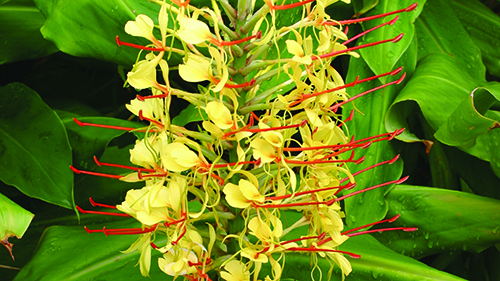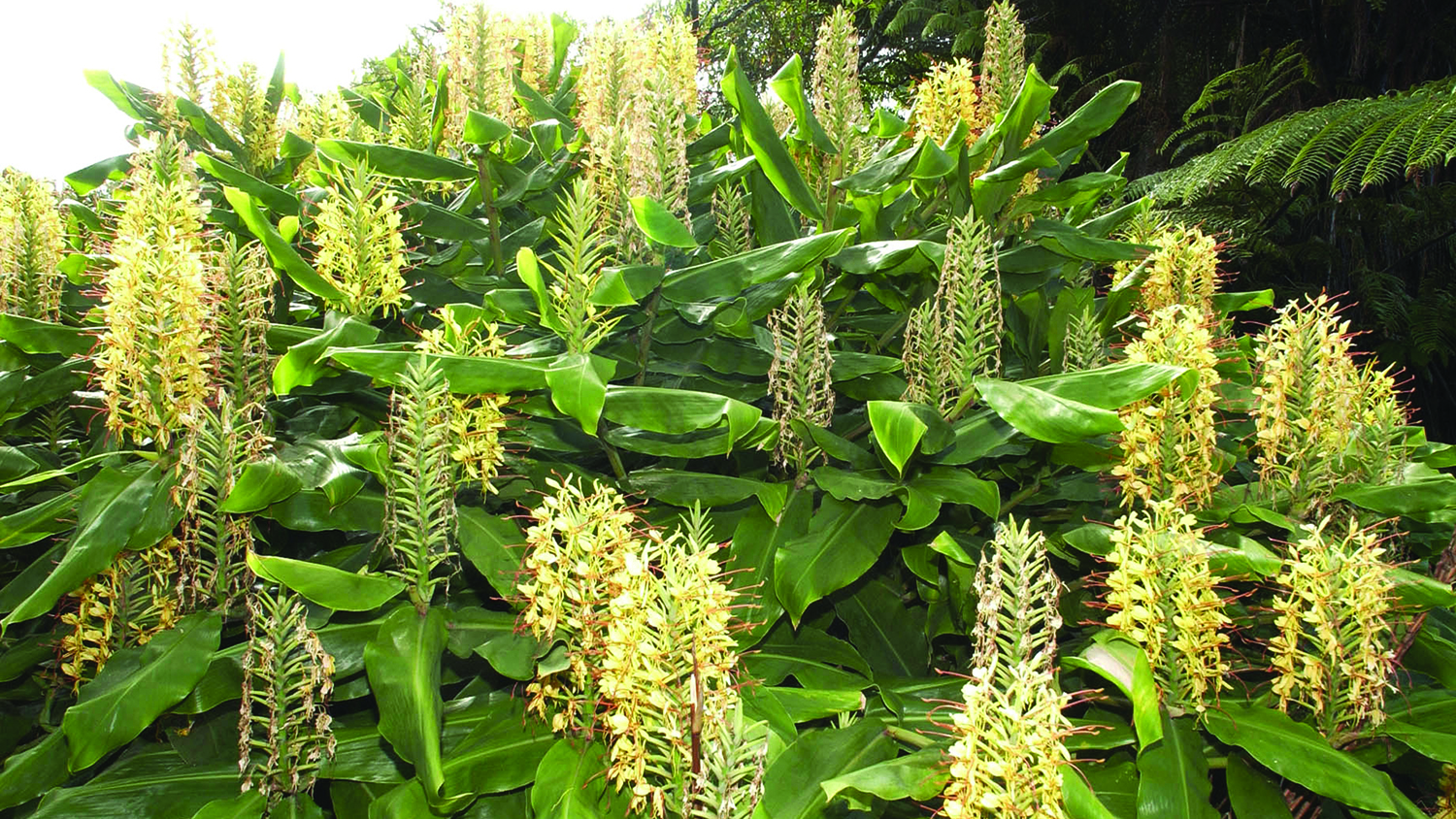| Management programme |
| Sustained control |
| Objectives |
| Keep wild ginger from affecting land free of or being cleared of it. |
| Impacts |
| Biodiversity, soil resources |
Wild ginger forms dense clumps in native forests, smothering young plants and preventing native seedlings from growing. This makes it a threat to native ecosystems. There are two types of wild ginger in New Zealand – kahili ginger (Hedychium gardnerianum), a native of India and Nepal, and yellow ginger (Hedychium flavescens), a native of India and Madagascar.

What does it look like?
Kahili ginger
Flower
- Large scented flowerheads (25cm-45cm long).
- Lemon-yellow flowers with red stamens.
- Flowers from January to March.
Fruit/seed
- Red seeds produced in fleshy orange fruit, around 100 per flowerhead.
Leaves/stems
- Large broad, shiny, waxy leaves, arranged alternatively on the stem.
- Leaved slightly hanging.
- Unbranched stems to 2m tall.
Roots
- Produces massive taro-like rhizomes close to the ground surface, shallow rooting.
Yellow ginger
Flower
- Small cone-like flowerhead.
- Small creamy yellow-white flowers.
- Flowers from May to June.
Fruit/seed
- No fruit produced in New Zealand.
Leaves/stems
- Leaves are narrower and more upright compared with kahili ginger.
- Taller than kahili ginger, stems to 3m high.
Roots
- Produces massive taro-like rhizomes close to the ground surface, shallow rooting.
Why is it a pest?
Both species of wild ginger (kahili and yellow ginger) present in New Zealand can grow to over 2 metres tall and produce deep beds of branching fleshing underground stems (called rhizomes). They form dense stands on the edges and through the understorey of forests, along the margins of water ways, on roadsides and in fernlands and shrublands. They can smother and replace all understorey species and seedlings. The rhizomes though dense are shallow rooted, so can be displaced on steep slopes after heavy rain, causing erosion.
In New Zealand only kahili ginger can set seeds. Kahili ginger seeds are spread by birds, with both species of ginger able to be spread and establish from pieces of their rhizomes. Many new infestations come from garden waste dumped in the countryside.
Control methods
Physical control
- Small seedlings can be hand pulled and disposed of carefully.
- Small clumps can be dug out, as long as all of the root system is removed and disposed of safely. Rhizomes can be placed in a black plastic bag and rotted, or placed in a weak herbicide mix, crushed, dried then burned. Larger clumps should be sprayed.
- When removing kahili ginger, remove flower heads as a stopgap before spraying or removing the whole plant. This won’t kill the plant but will stop it from seeding that year. Burn the seed heads.
Herbicide control
Cut stump treatment
- To treat larger plants, slash stems horizontally near the roots. Immediately apply the herbicide to the stems and roots with a paintbrush or small squeeze bottle. Leave the plants in the ground until the roots have dried off.
- If using the herbicide picloram gel and the plant has more than four rhizomes per shoot, also drill a 10mm hole into every fourth rhizome (from a shoot to 80 per cent the depth of the rhizome). Fill the hole with picloram gel.
Spray application
- Totally cover the foliage and roots until they are wet but not dripping. Be careful not to spray desirable plants. Do not remove the leaves or stems until they have gone brown and dried out (three or four months). Best results are achieved from spring to late autumn.
- Alternatively, cut and remove all stems and leaves and rake away ground litter to expose the rhizomes, spray them, and then cover with leaves. The plant may take 12 to 15 months to fully die and rot. This method is particularly suitable for densely covered steep banks where removal of the ginger could cause problems.
Safety when using herbicides
- Follow the instructions on the manufacturer’s label.
- Always wear protective clothing.
- Always minimise the risk to your other plants.
- Contact the supplier for further advice.
Summary of herbicides and application methods for control
| Herbicide | Application |
| Metsulfuron, triclopyr/picloram mix | Cut stump treatment, knapsack spray application, handgun application. |
| Picloram gel | Cut stump treatment. |
| Herbicide rules will apply. You may need to notify neighbours if spraying. The Waikato Regional Plan explains the agrichemical (herbicides) use rule in section 6.2. | |
| If applying herbicide over water, a resource consent may be required. Please check with Waikato Regional Council before you begin. | |
Herbicides rule will apply. You may need to notify neighbours if spraying. The Waikato Regional Plan explains the agrichemical (herbicides) use rule in section 6.2.
Management
After initial control, it’s important to:
- clean out the site again at least annually to control regrowth
- stop weeds invading by replanting with non-pest plants (preferably native plants) once regrowth is no longer a problem.
More information
Advice
- For advice and additional information on wild ginger control methods, call our pest plant staff on freephone 0800 800 401.
- Chemical company representatives, farm supply stores, garden centres or the Weedbusters website can also be good sources for advice.
Publications
The following publications are available for download or from Waikato Regional Council. Contact us to request a copy (freephone 0800 800 401).






To ask for help or report a problem, contact us
Tell us how we can improve the information on this page. (optional)